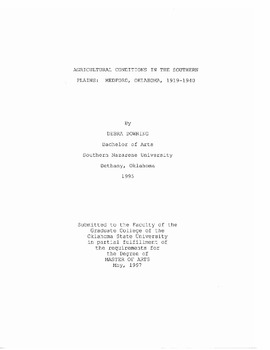| dc.description.abstract | The history of a small farming community such as Medford, Oklahoma, is significant to western history for a number of reasons. Medford developed as a typical southern plains town, experiencing boom and bust cycles, and growth and decline. Market, weather, and population patterns affected the prosperity of the town, and as such are good examples of how these phenomena affected a rural, agricultural community in the Southern Plains. Land hungry pioneers established Medford during the Cherokee Strip land rush of 1893. This land rush opened additional Indian lands to white settlement. Overnight the prairie became towns and farms as thousands of eager and optimistic souls sought their future on free lands. Most of these people either had a farming background or aimed to acquire one. The land was only marginally suitable for agriculture during some years, and in fact the United States government had sent explorers into the region early in the nineteenth century, and these men had labeled the region the Great American Desert. Medford residents would learn just what this label meant as they plowed up the ground and sought to feed their families and build homes. An agricultural boom occurred in the United States during World War I, as the demand for food to support the war effort, and the mechanization of agriculture, prompted what some have called the great plow-up. After the war, and throughout the 1920s, while much of the nation prospered, agricultural interests suffered as they were geared to production levels that created oversupply of products that led to a severe decline in prices. Thus, by the end of the 19208, communities such as Medford had experienced a decade of a declining prosperity. This is a study of Medford, Oklahoma, from the post World War I period until 1940. The purpose of this work is to demonstrate that the Medford area, dependent for its economic livelihood upon agriculture, from time to time suffered economic depression related primarily to national and international agricultural overproduction before 1930 and not the effects of the Dust Bowl or Great Depression. Essentially, I wish to argue that for a number of reasons, the Medford region during the 1930s experienced no worse economic downturn than it had prior to either of these phenomena. Implicit in this description of economic hardship during the Dust Bowl and Great Depression is also the question of whether the area is suitable at all for farming. Beginning in 1929, with the stock market crash, the United States economy entered a downward spiral that lasted until the late 1930s. During this period, Medford, subject to depression and Dust Bowl conditions, suffered as did the rest of the nation, but as declining agricultural prices had occurred in the previous decade, the town and its area were affected less severely as other regions, especially urban areas. Many historians have suggested the causes of the Dust Bowl, and have taken positions on whether the region should be farmed. R. Douglas Hurt in The Dust Bowl; An Agricultural and Social History argued that soil composition, climactic conditions, and white settlement caused the ecologically devastating Dust Bowl. 1 But his conclusions indicated that farmers learned from their Dust Bowl experiences and even gained two things from the blowing dust: the Soil Conservation Service and the increased use and knowledge of irrigation. Hurt was careful not to lay the entire blame of the Dust Bowl on the farmers' individualism. Another work whose premise is similar is James C. Malin's The Grasslands of North America: Prolegomena to Its History. Malin argued that the Dust Bowl was not unique when placed in its historical context. In fact, dust storms of the severity of the 1930s occurred throughout the Southern Plains for hundreds of years. Man, with increased technology, plowed up more sad and produced higher yields, but this did not affect the blowing dust storms of the 1930s. Disagreeing with Malin, Donald Worster in Dust Bowl: The Southern Plains in the 1930s argued that man and his, capitalistic ideals in the United States created the Dust Bowl. 3 Individual human greed motivated the increase in acreage and the exploitation of the soil to its limits. He concluded that droughts would occur in the 1970s and the 1990s because of the flaws inherent in the American economic system that related to the farmer's activities. Though one may wonder whether these arguments have a limited significance to this thesis, it is essential to understand that these diverse interpretations of the causes and conclusions had relevancy for Medford. Medford remains as the economic hub of Grant County because of the cooperative grain elevators access to national markets. Worster argued that much of the Southern Plains should not be farmed owing to the extreme individualism and capitalism inherent in the United States' economic system. Worster's perception would cause Oklahoma's largest wheat producing county to be depopulated, and Medford would have become a virtual ghost town. All businesses in the town depend heavily on the enterprise of wheat farming. Worster was not alone in his attitude toward farming in the Southern Plains. Nineteenth-century explorers in the region also argued that the aridity made large-scale farming impossible, or at best risky. Zebulon M. Pike, Major Stephen H. Long, Captain Randolph B. Marcy, and Horace Greely agreed that the region should be pastured out or not inhabited at all. The conclusions of this thesis support the ideas that R. Douglas Hurt suggested about whether or not the land should be farmed. Hurt believed that the Southern Plains was suitable for agriculture, if proper techniques were used and the farmers respected nature's cycles. Land use has as much to do with cultural and aesthetic judgments - not just economics as Worster presumes. Thus people farm because of this desire for the lifestyle. | |
